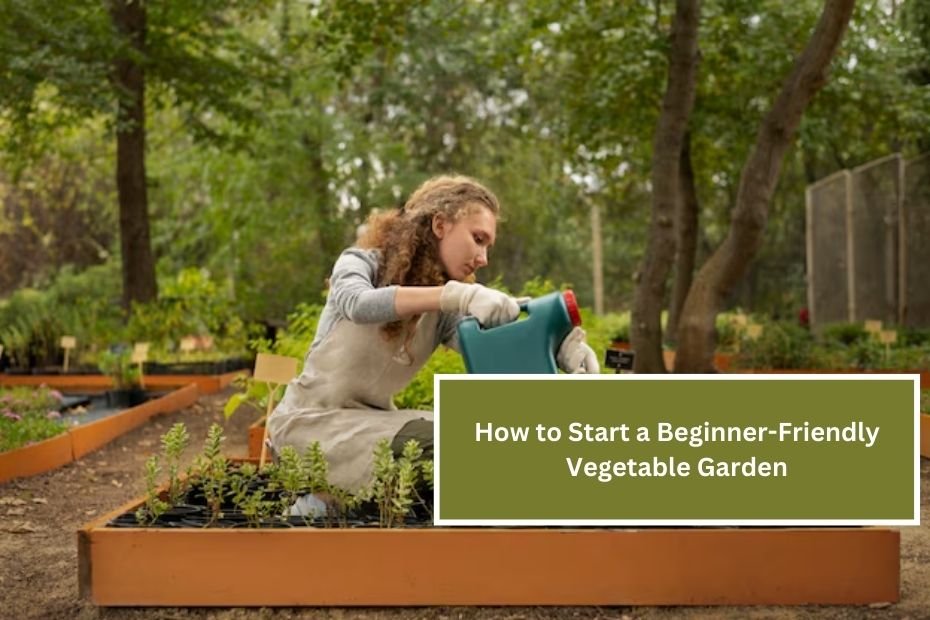Starting a vegetable garden can be a fun and rewarding experience, especially for beginners. Whether you’re looking to grow fresh vegetables for your meals, save money, or simply enjoy the benefits of gardening, this guide will help you get started. With a few simple steps, you can create a garden that provides healthy, delicious produce throughout the season.
1. Choosing the Right Location
The first step to starting a vegetable garden is choosing the right spot. Location is key for a healthy garden, so consider the following:
- Sunlight: Most vegetables need at least 6-8 hours of direct sunlight each day. Choose a spot in your yard or balcony that gets plenty of sunlight.
- Soil quality: Good soil is essential for growing vegetables. Check the soil for drainage by digging a small hole and filling it with water. If the water drains within a few minutes, your soil has good drainage. If it takes longer, you may need to improve it by adding organic material like compost.
- Access to water: You’ll need to water your garden regularly, so pick a spot that’s close to a water source like a garden hose or rain barrel.
- Space: Ensure there’s enough space for your vegetables to grow. Some vegetables, like tomatoes and zucchini, need more room, while others, like lettuce or radishes, can be grown in tighter spaces.
2. Picking Your Vegetables
For beginners, it’s best to start with easy-to-grow vegetables. Here are some great choices:
- Tomatoes: One of the most popular vegetables, tomatoes are easy to grow and come in many varieties.
- Lettuce: Lettuce grows quickly and is perfect for a beginner garden. You can harvest it multiple times during the growing season.
- Carrots: Carrots are a root vegetable that grows best in loose, sandy soil.
- Radishes: Radishes are fast-growing and can be harvested in as little as 3-4 weeks.
- Peppers: Bell peppers and hot peppers are fun to grow and can be used in many dishes.
- Zucchini: This summer squash grows quickly and produces a large yield.
3. Preparing the Soil
Healthy soil is the foundation of a successful garden. Before planting, you’ll need to prepare your soil.
- Testing the soil: You can buy a simple soil testing kit from a gardening store to check the pH levels. Most vegetables thrive in slightly acidic to neutral soil, with a pH of 6.0 to 7.0.
- Adding compost: If your soil is lacking nutrients, add compost or organic matter. This will improve the soil’s texture, help retain moisture, and provide essential nutrients to your plants.
- Loosening the soil: Use a garden fork or tiller to loosen the soil to about 8-12 inches deep. This helps roots grow easily and allows water and air to reach them.
4. Planning Your Garden Layout
Planning the layout of your garden is important for maximizing space and ensuring plants get enough sunlight.
- Rows: A simple layout involves planting vegetables in rows. Keep taller plants, like tomatoes and corn, in the back, so they don’t block the sunlight from shorter plants like lettuce or carrots.
- Raised beds: Raised beds are a great option if you have poor soil. You can control the soil quality, and they offer better drainage. They are also easier to maintain.
- Container gardening: If you don’t have much space, growing vegetables in containers is a great option. Just make sure to choose large enough containers and ensure they have proper drainage.
5. Planting Your Vegetables
Once your soil is ready, it’s time to plant your vegetables.
- Planting seeds: Some vegetables, like carrots and radishes, are best grown from seeds. Follow the instructions on the seed packet to know how deep to plant them and how far apart they should be spaced.
- Transplanting seedlings: For vegetables like tomatoes and peppers, it’s easier to start with seedlings. Dig a hole slightly larger than the root ball of the seedling, place it in the hole, and cover it with soil. Gently pat the soil down to secure the plant.
- Spacing: Make sure to leave enough space between each plant to allow them to grow. Overcrowding can lead to poor growth and increase the risk of disease.
6. Watering Your Garden
Watering is crucial for the health of your vegetable garden. Here are some tips:
- Consistent watering: Vegetables need regular watering, especially when they’re young. Water your plants deeply 2-3 times a week, depending on the weather.
- Morning watering: Watering in the morning is best because it gives the plants time to absorb moisture before the heat of the day.
- Mulching: Add a layer of mulch around your plants to help retain moisture and prevent weeds.
7. Fertilizing Your Vegetables
Fertilizing helps ensure your vegetables get the nutrients they need to grow. Organic fertilizers like compost, manure, or fish emulsion are great choices.
- When to fertilize: Fertilize your garden when you first plant your vegetables, and then continue to fertilize throughout the growing season. Some vegetables, like tomatoes and peppers, need more frequent feeding.
- How to fertilize: Follow the instructions on your fertilizer packaging. Be careful not to over-fertilize, as this can harm your plants.
8. Managing Pests and Diseases
Garden pests and diseases can harm your vegetables, but there are natural ways to prevent and manage them:
- Companion planting: Planting certain vegetables together can naturally repel pests. For example, planting marigolds near tomatoes can help keep away harmful insects.
- Natural pest control: Use natural methods like neem oil or insecticidal soap to get rid of pests. You can also attract beneficial insects like ladybugs to your garden to help control pests.
- Healthy plants: Keep your plants healthy by providing them with proper watering, sunlight, and nutrients. Healthy plants are less likely to get sick or be affected by pests.
9. Harvesting Your Vegetables
The most exciting part of gardening is harvesting your vegetables. Here’s how to do it:
- Know when to harvest: Each vegetable has its own timeline for harvesting. Check the seed packet or plant label for the recommended harvest time.
- Pick often: Harvesting vegetables regularly encourages more growth. For example, the more you pick beans or cucumbers, the more the plant will produce.
- Be gentle: When harvesting, be careful not to damage the plant. Use scissors or pruning shears to cut the vegetables, especially for delicate plants like tomatoes.
10. Maintaining Your Garden
Regular maintenance is key to a thriving garden. Here are a few things you should do:
- Weeding: Weeds compete with your vegetables for nutrients and sunlight, so make sure to pull them out regularly.
- Pruning: Some plants, like tomatoes, benefit from pruning to remove dead or excess leaves.
- Rotating crops: To avoid soil depletion and reduce the risk of diseases, rotate your crops each year. For example, plant beans in the area where you grew tomatoes last year.
Conclusion
Starting a beginner-friendly vegetable garden doesn’t have to be difficult. By choosing the right location, picking easy-to-grow vegetables, and taking care of your plants with proper watering, fertilizing, and pest management, you can enjoy fresh, home-grown produce. Gardening is not only a way to eat healthier but also a relaxing hobby that connects you with nature. Over time, you’ll gain more confidence and experience, allowing you to expand your garden and grow a wider variety of vegetables. Happy gardening!

